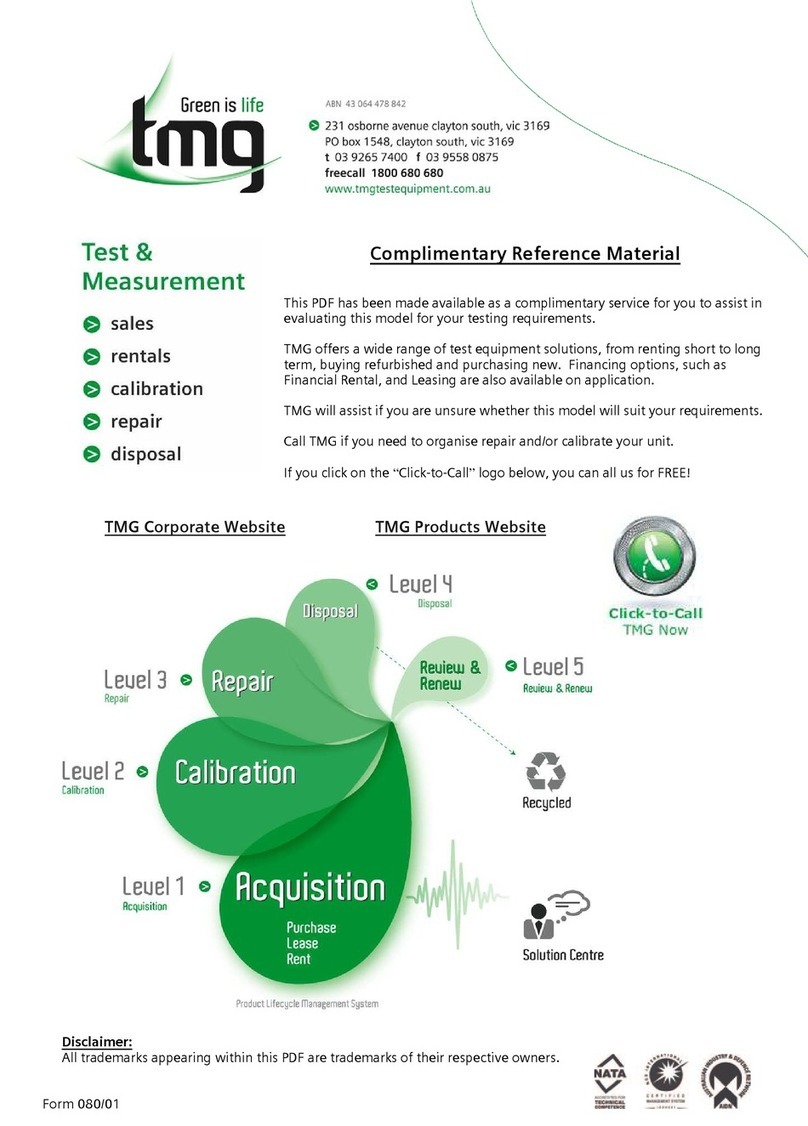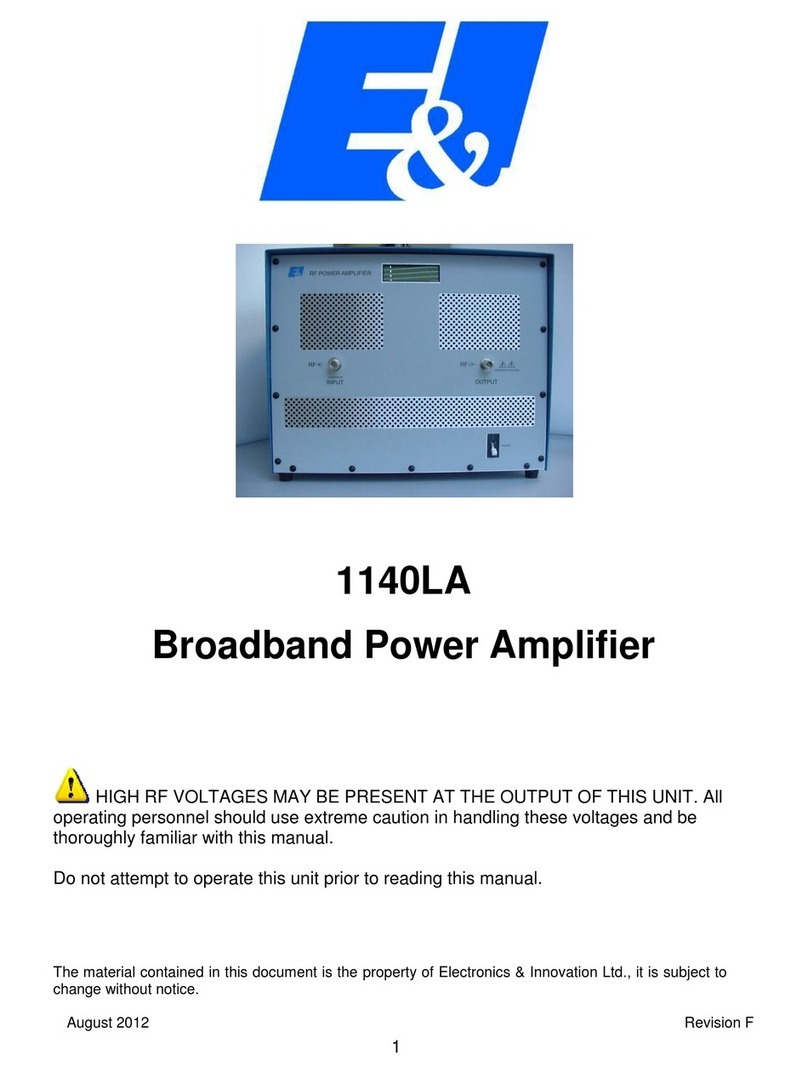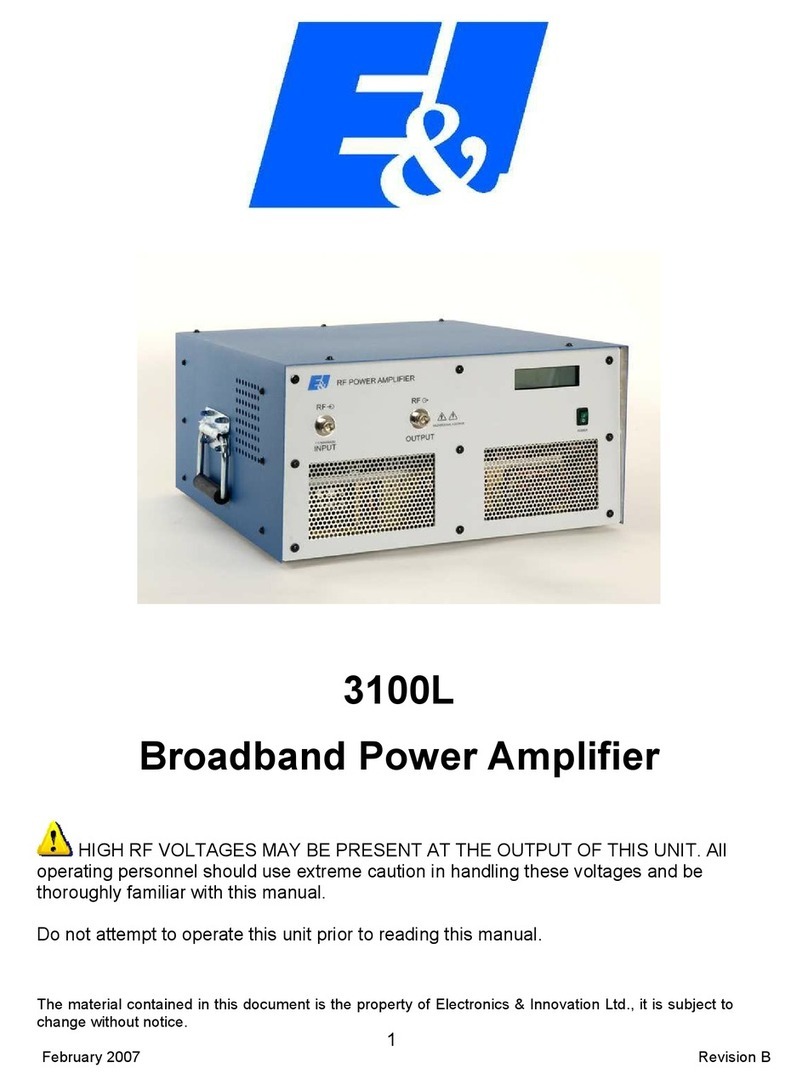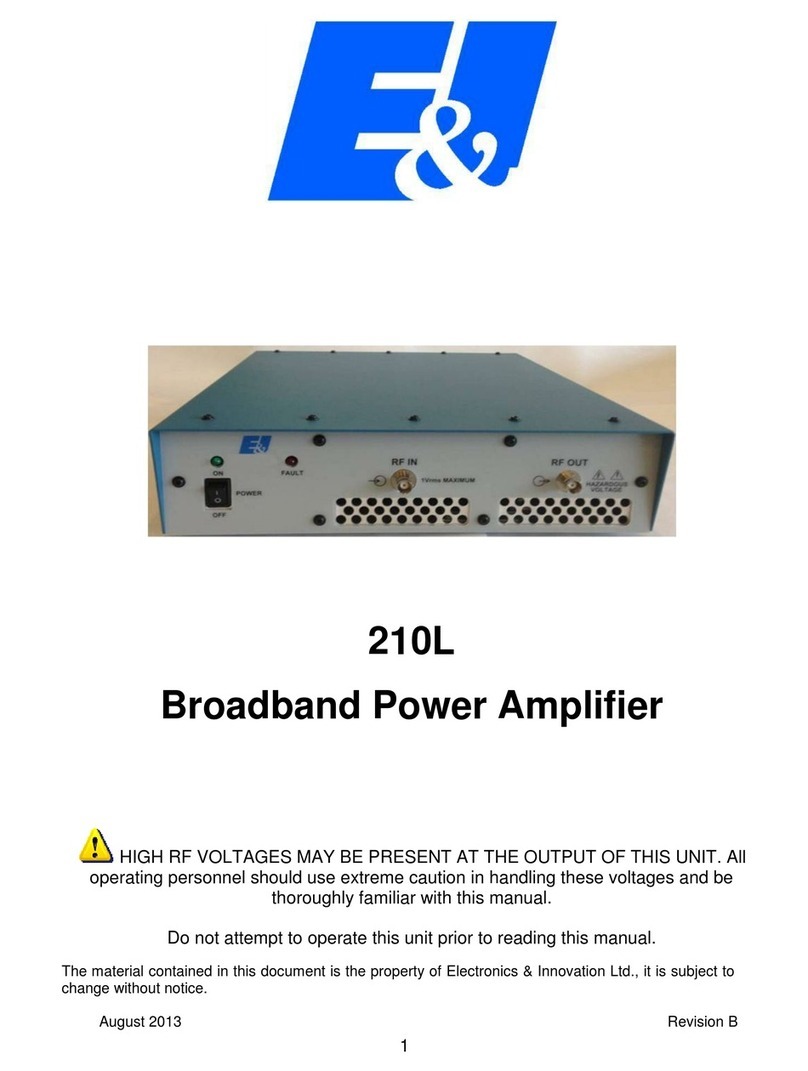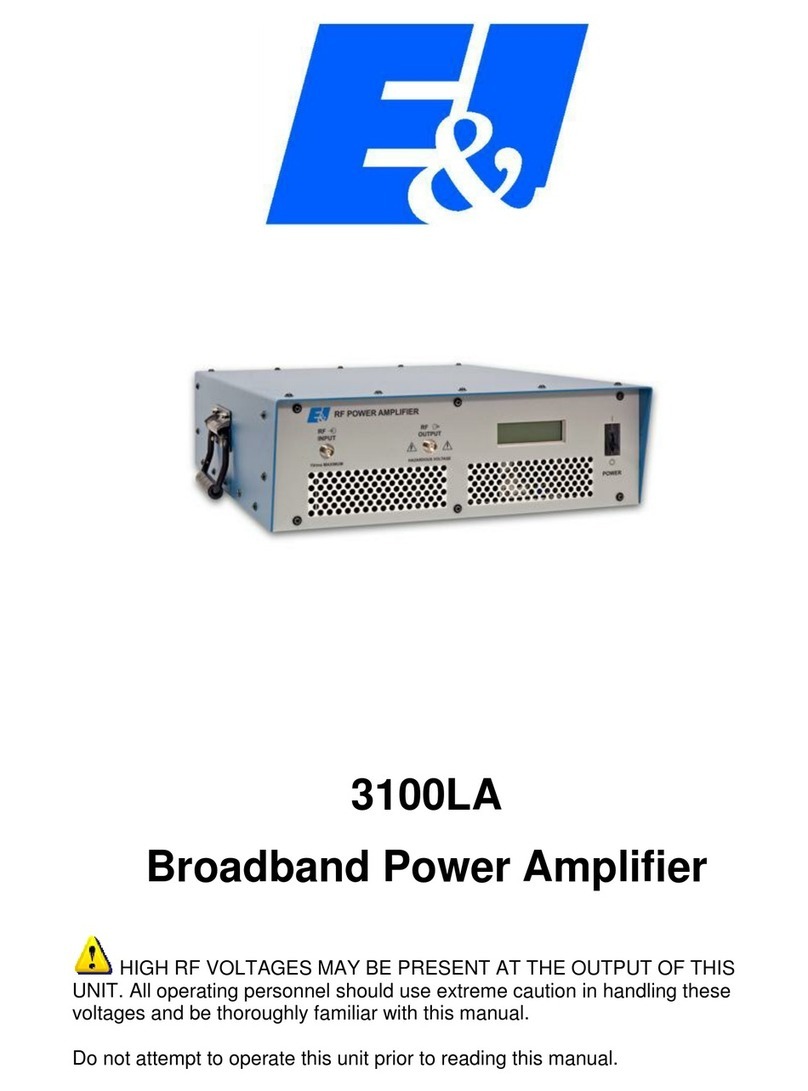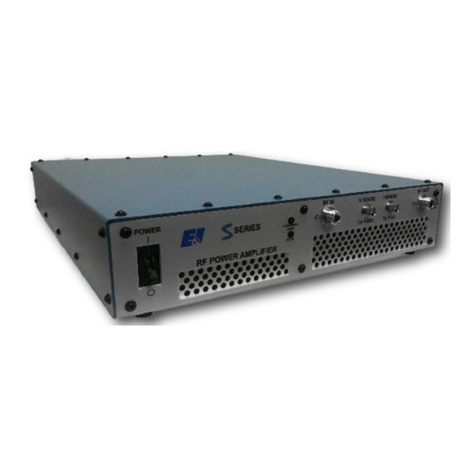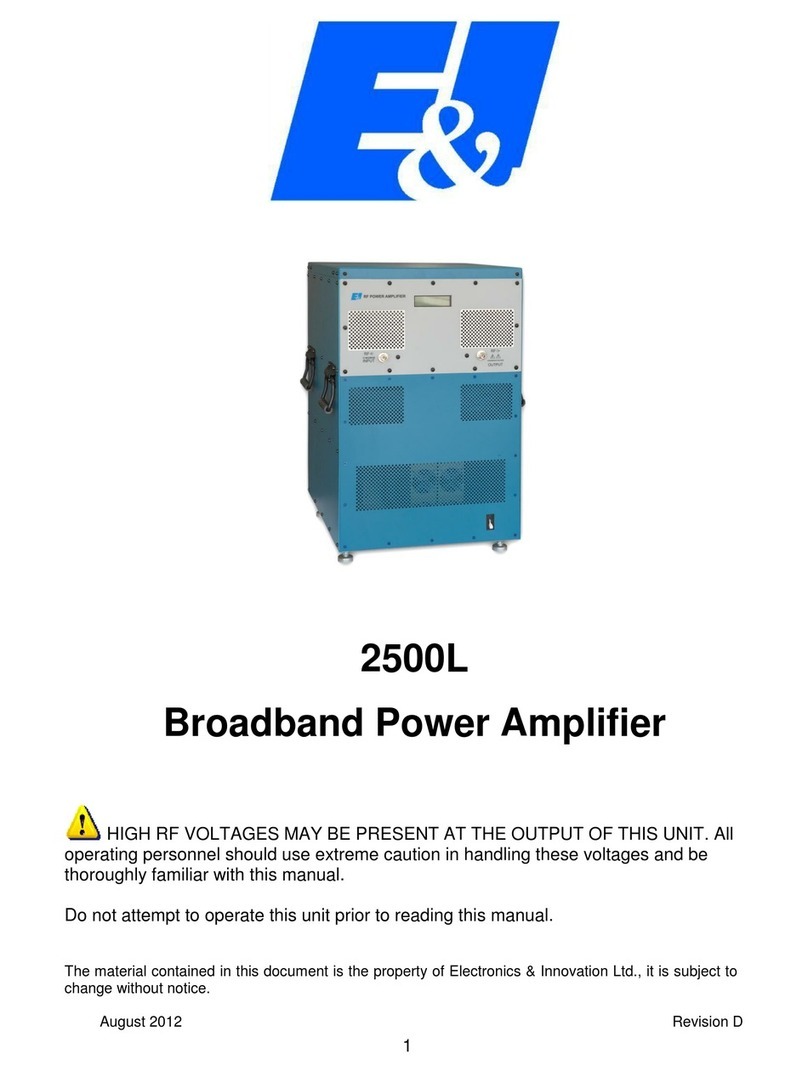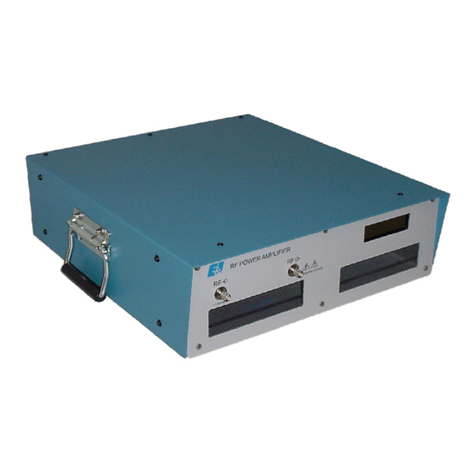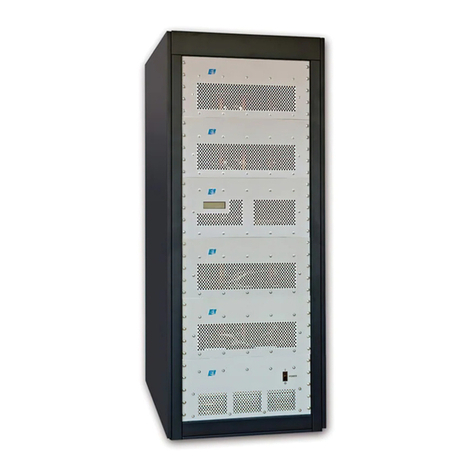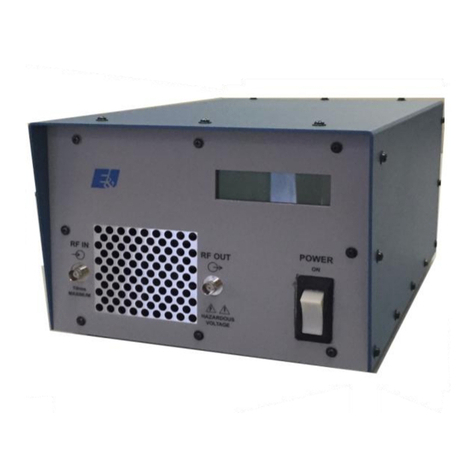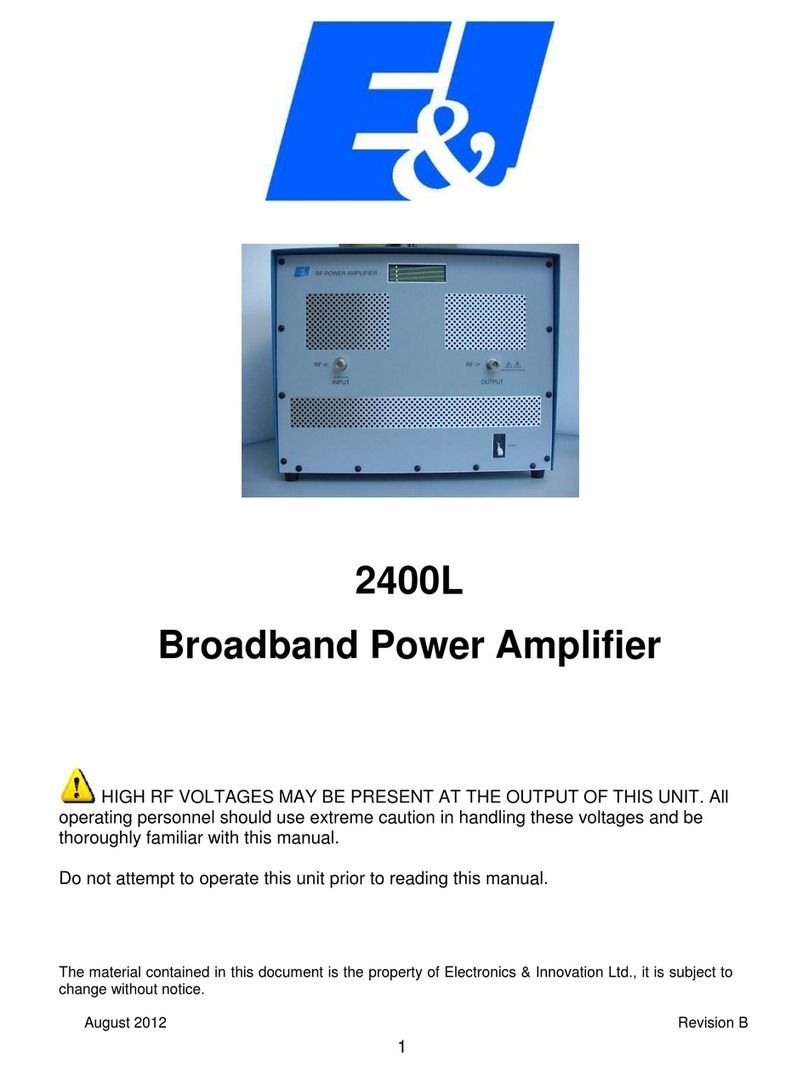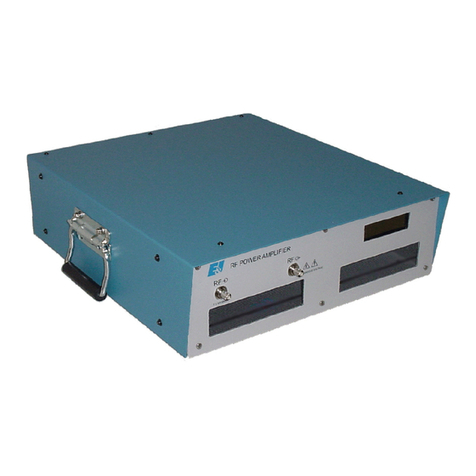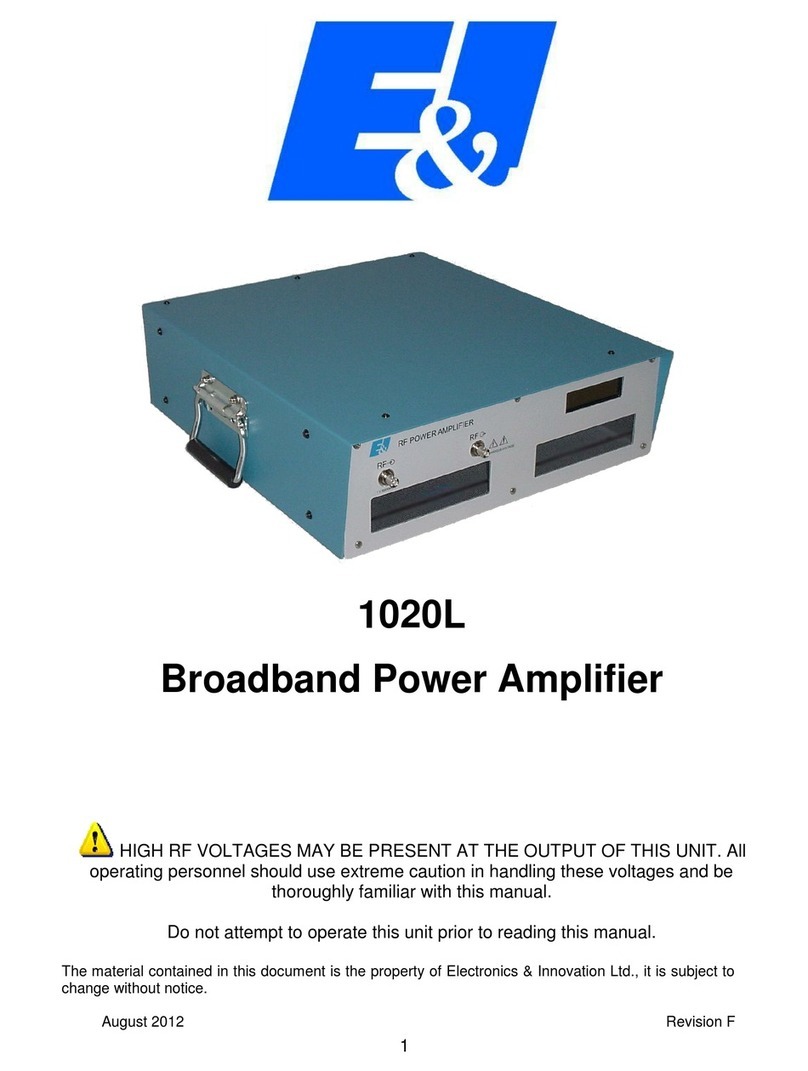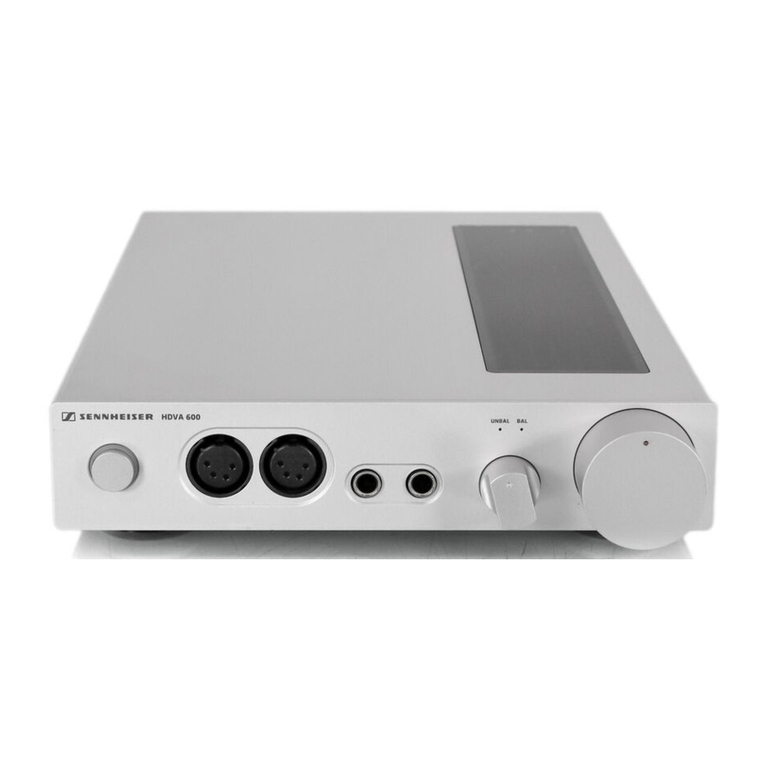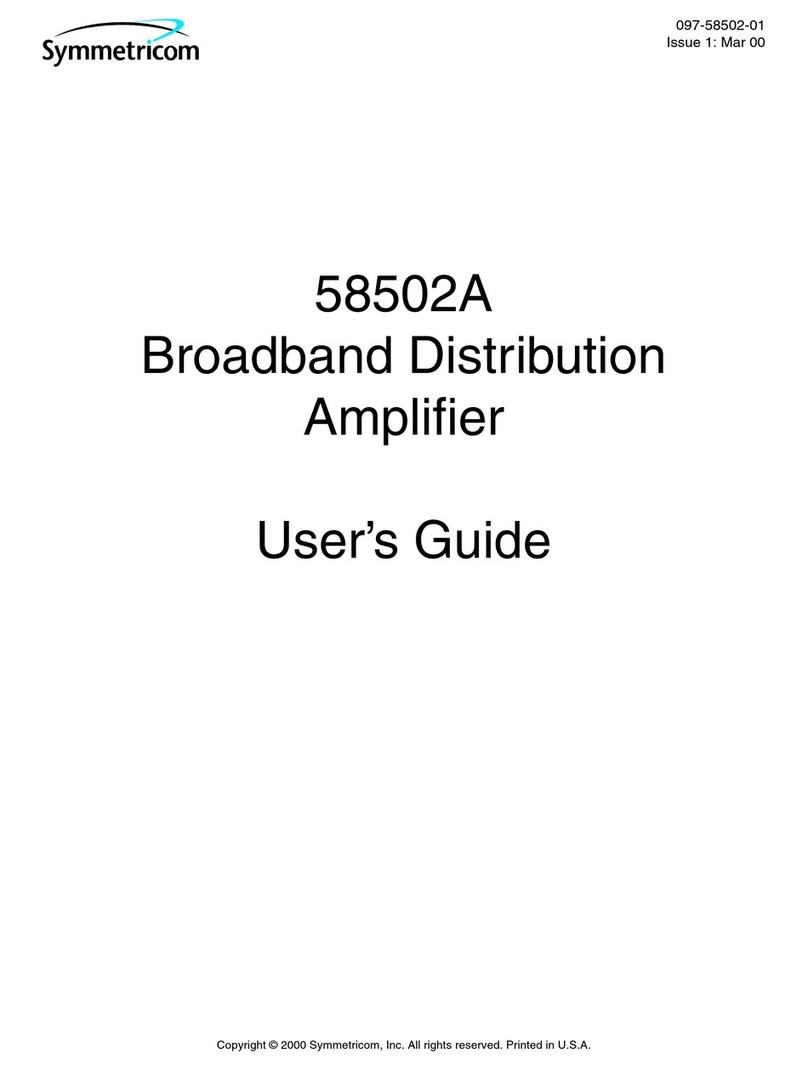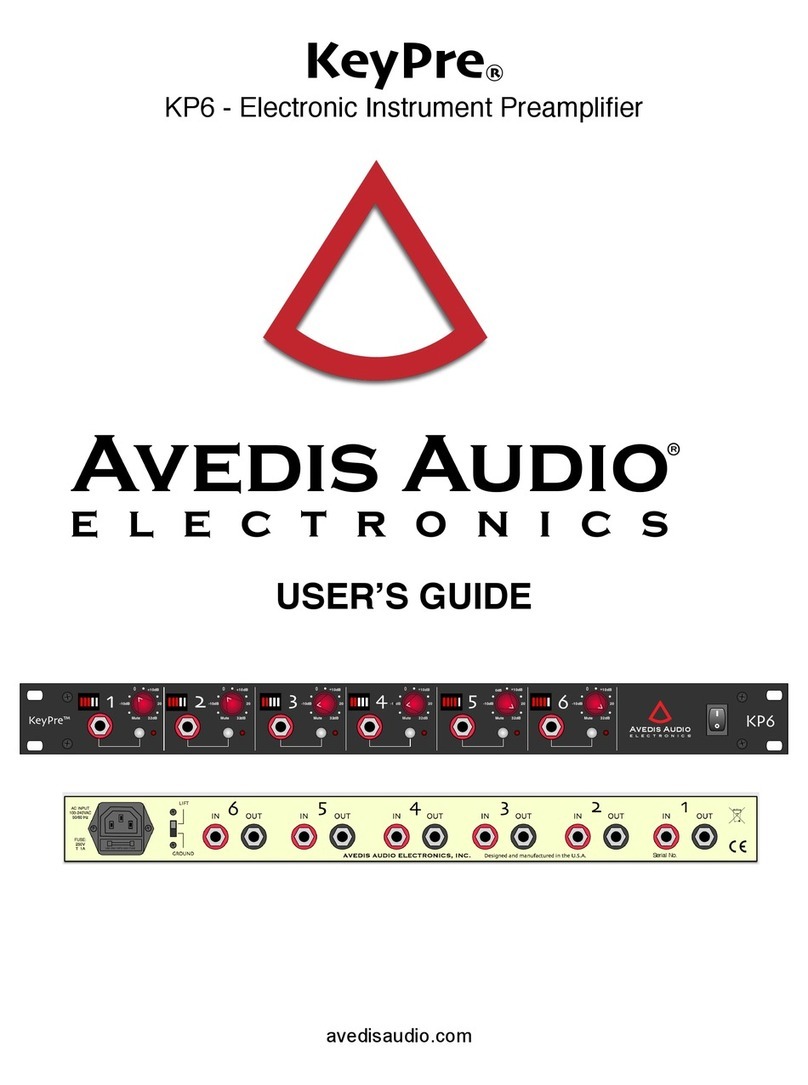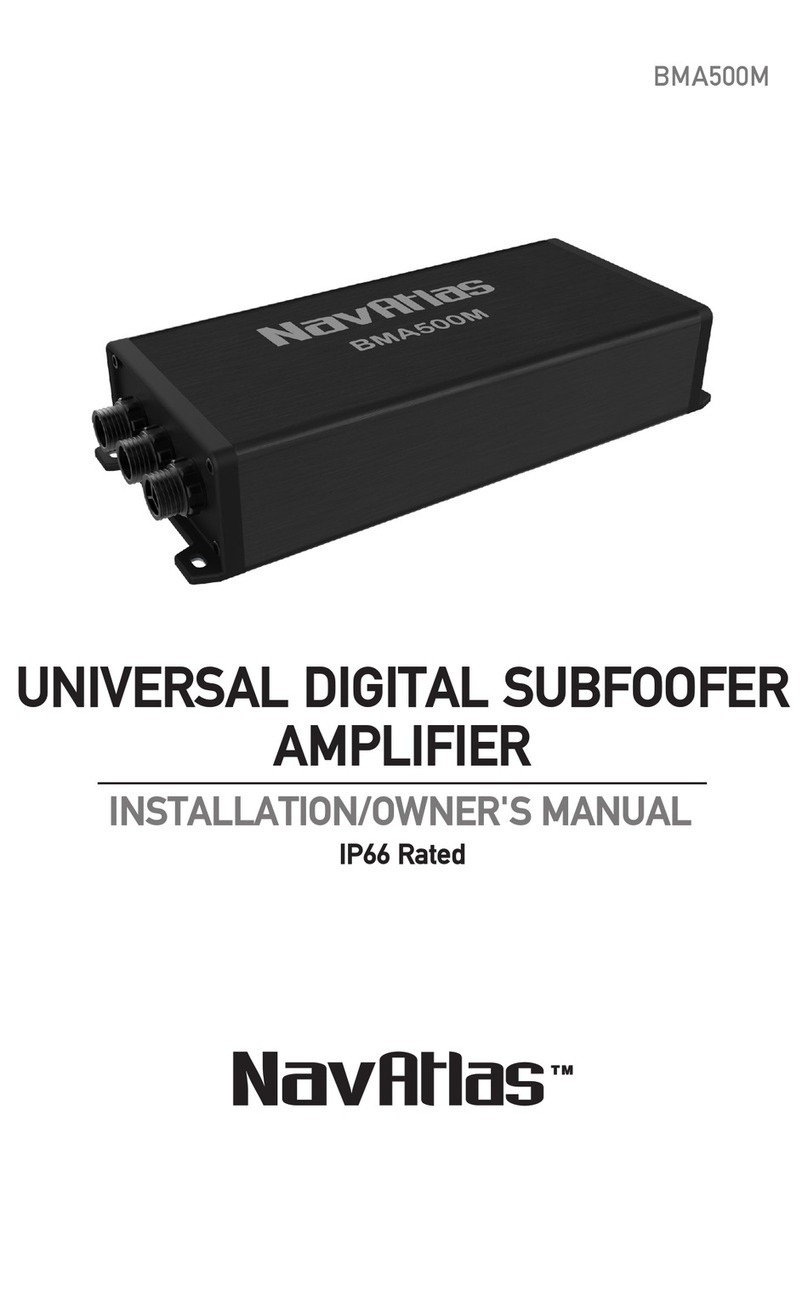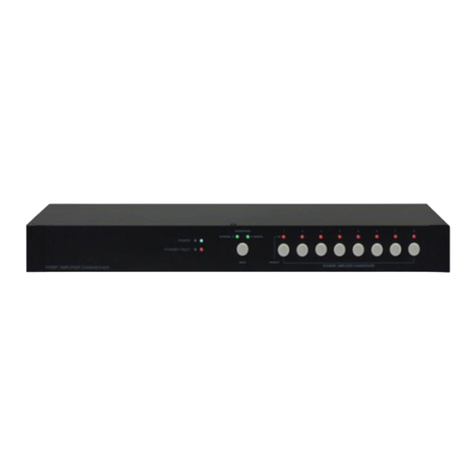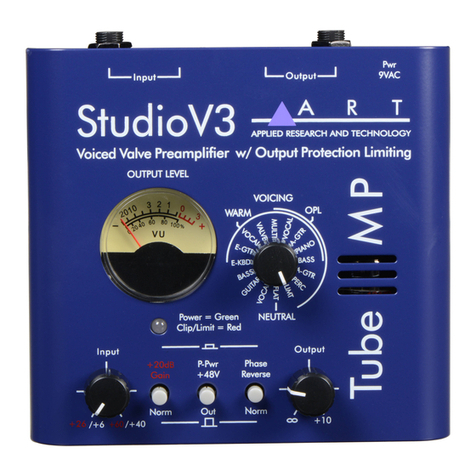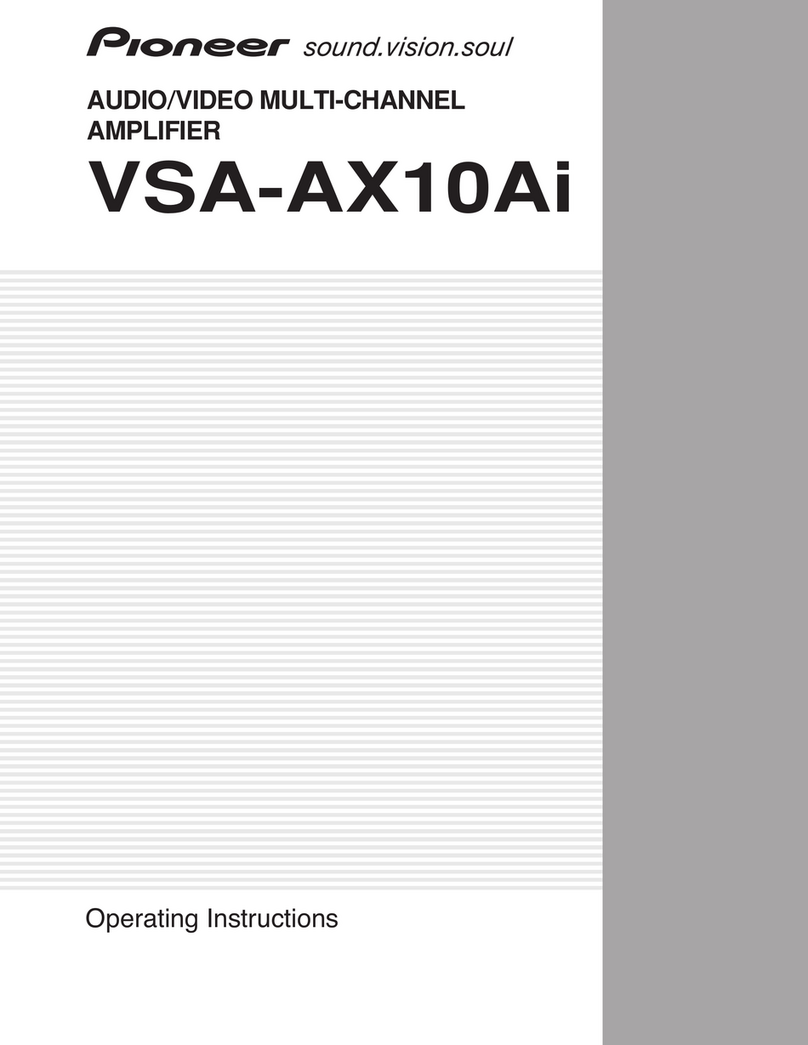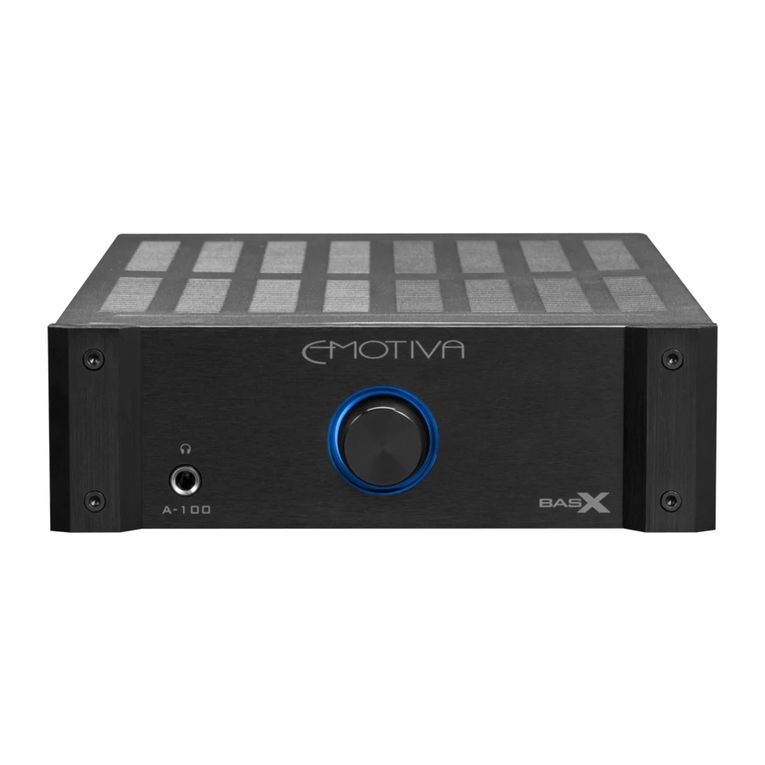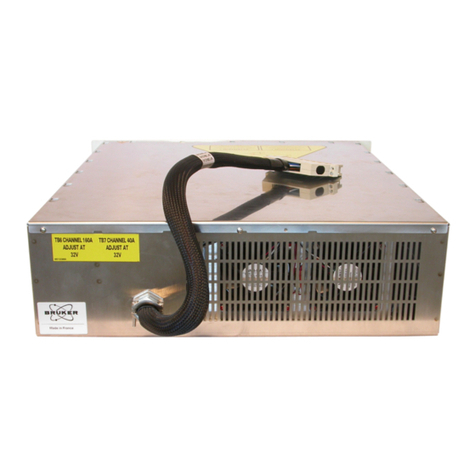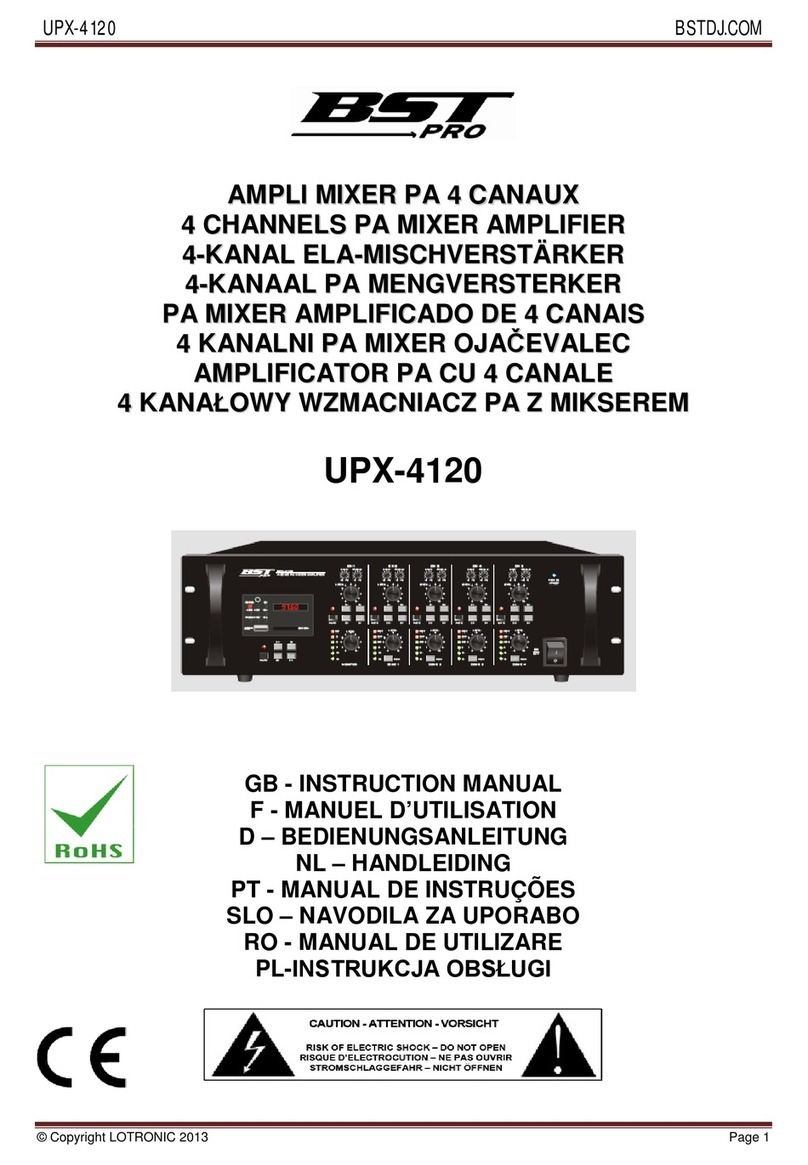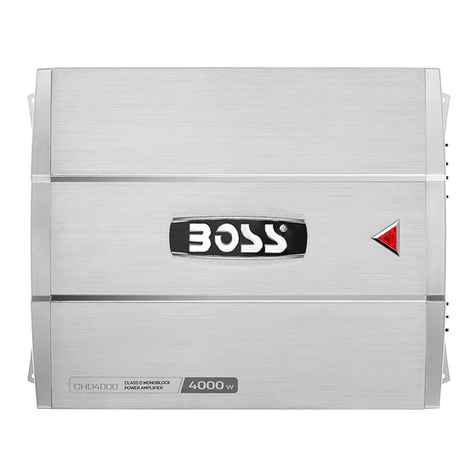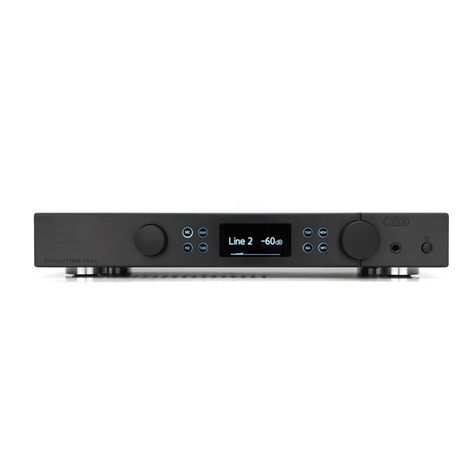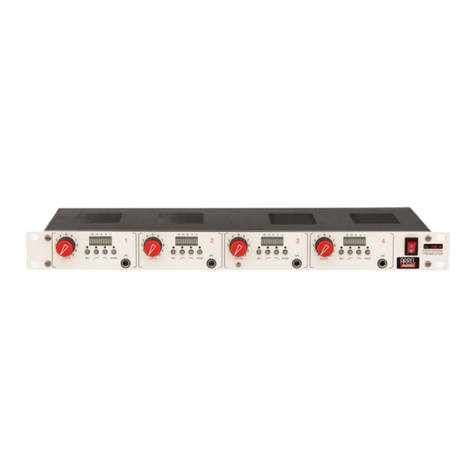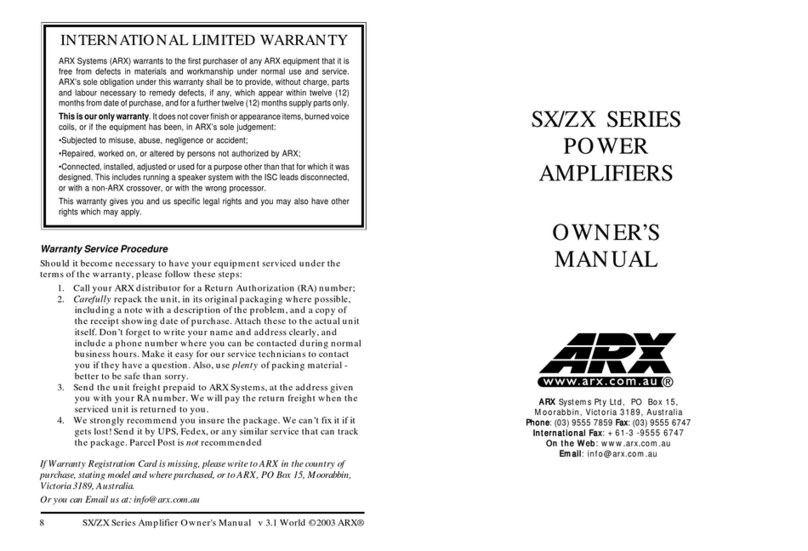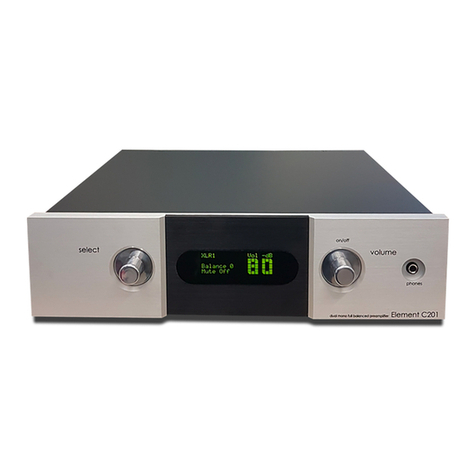E&I 1040L User manual

The material contained in this document is the property of Electronics & Innovation Ltd., it is subject to
change without notice.
March 007 Revision B
1
1040L
Broadband Power Amplifier
HIGH RF VOLTAGES MAY BE PRESENT AT THE OUTPUT OF THIS UNIT. All
operating personnel should use extreme caution in handling these voltages and be
thoroughly familiar with this manual.
Do not attempt to operate this unit prior to reading this manual.

The material contained in this document is the property of Electronics & Innovation Ltd., it is subject to
change without notice.
March 007 Revision B
Warranty
Electronics & Innovation Ltd., (hereafter E&I) warrants for the period of one year from the
date of original delivery, each unit to be free of defects in materials and workmanship. For
the period of 1 months E&I will, at its option, repair or replace defective parts so as to
render the unit fully operational such that it performs according to the original
specifications; free of charge to the original purchaser.
Should warranty service be required, the unit must be returned to E&I, freight cost to be
borne by the owner. If, in our opinion, the unit has been damaged by use outside the
limits prescribed in this manual or by accident, then the warranty shall not be honored. In
such a case E&I will provide an estimate for repair, assuming repair is possible and
provide a quote at standard service rates.
Contents
Chapter 1
General Information……………………………………………………………3
Chapter
Operation………………………………………………………………………..4
Chapter 3
Technical Information………………………………………………………….7
Chapter 4
Maintenance……………………………………………………………………8
Chapter 5
Safety……………………………………………………………………………1

The material contained in this document is the property of Electronics & Innovation Ltd., it is subject to
change without notice.
March 007 Revision B
3
Chapter 1 Introduction
The 1040L is a broadband solid state amplifier covering the frequency spectrum from 10
KHz to 5 MHz. It is rated at 400 watts of RF power from 30 KHz to 5 MHz. Over 500 watts
of saturated power can be produced with increased distortion products. A highly linear
Class AB design, the 1040L will amplify inputs of AM, FM, SSB, pulse and any complex
modulation signals. The amplifier has 55 dB gain, it is unconditionally stable and will not
oscillate even with combinations of mismatched source and load impedance. It is
protected against failure due to output load mismatch and/or overdrive.
RMS forward and reverse powers are monitored by a front panel meter. An integral power
supply permits operation from 115/ 30 single phase AC power.
1. INSTRUMENTATION IDENTIFICATION
Each amplifier is identified by a serial number tag on the back panel of the unit. Both the
model number and the serial number should be quoted to identify specific unit.
1.3 SPECIFICATIONS
Physical and electrical specifications are listed in Table 1-1 below

The material contained in this document is the property of Electronics & Innovation Ltd., it is
subject to change without notice.
March 007
4
Revision B
Table 1-1. SPECIFICATIONS
FREQUENCY COVERAGE: 10 kHz to 5 MHz.
GAIN: 55 dB min, ±1.5 variation.
CLASS AB QUASI LINEAR OUTPUT: Nominal 400 watts.
SATURATED RF POWER OUTPUT:
300W Min. from 10kHz – 30KHz;
450W Min. from 30kHz – 500KHz;
500W Min. from 500KHz - MHz.
INPUT IMPEDANCE 50 ohms, VSWR, 1.5:1 Maximum.
OUTPUT IMPEDANCE: 50 ohms, VSWR, .5:1 Maximum
STs STABI
LITY: Continuous operation into any load or
source impedance.
PROTECTION:
Unit will withstand a + 13dBm input
signal (1.0 Volts RMS) for all output load
conditions, without damage.
POWER OUTPUT METER: True RMS power detection. ±3% of full
scale accuracy.
POWER REQUIREMENTS: 85 – 64 VAC 47-63 Hz.
SIZE: 5 1/4 X 16.5 X 18.1inches 13.4 X 41.9 x
46.0 cm.
WEIGHT: 5 .5 pounds 3.8 kg
CONNECTORS: BNC
OPERATING TEMPERATURE: 0 – 40 C
RACK MOUNTING:
Chapter Operation
.1 INTRODUCTION
The 1040L RF amplifier is used to amplify the RF level of signal sources in the 10
KHz to 5 MHz range. No tuning or any other form of adjustment is required.
The 1040L produces power output at its output connector, regardless of load
impedance. Any power reflected due to output load mismatch is absorbed in the
amplifier. Therefore, although the output impedance is 50 ohms (maximum
VSWR: .5:1), the amplifier will work into any load impedance at reduced output
power.

The material contained in this document is the property of Electronics & Innovation Ltd., it is
subject to change without notice.
March 007
5
Revision B
. RACK INSTALLATION
This unit is 3U high, 16.5” width. With the handles removed it will fit into a
standard rack.
. .1 Mains Voltage
The unit accommodates AC line voltages from 85 TO 64 VAC 47 – 63 Hz
.3 OPERATION
A line cord is supplied to form a connection between the mains supply and the
rear of the unit. Plug this into the AC input at the rear of the unit and the AC
mains outlet.
.3.1 Proceed as follows:
(i) Ensure that there is at least 3” or 7.5 cm clearance at the rear of the
unit for air flow.
(ii) Ensure RF input voltage is not excessive
a. The 1 V rms indicated maximum input voltage is 5 times the level of
the input signal required to achieve maximum output. Input voltages
in excess of volts peak may permanently damage the instrument.
(iii) Connect the output via a 50 ohm coaxial lead and BNC plug to the
load.
(iv) Connect the input signal via a 50 ohm coaxial lead and BNC plug to
the input connector.
.3. Front Panel Display
The 1040L front panel has a passive LCD display designed for simplicity and
ease of use. During initialization, the LCD shows the software revision. After the
amplifier is initialized, the LCD indicates Forward Power, Reflected Power, and
amplifier status (see figure .1).
Pf:___W Pr:___W
Status:________
Figure 2.1 : Front Panel Display
Where Pf refers to forward power, Pr refers to reverse power, and Status
indicates “OK” unless there is a fault condition, such as:
• Overheat (heat-sink temperature is too high for reliable operation)

The material contained in this document is the property of Electronics & Innovation Ltd., it is
subject to change without notice.
March 007
6
Revision B
• PSU fault (internal fault in the main switching power supply)
In the event of a fault, the unit may be reset by cycling the power. In the case
over an over temp fault, ensure that the air inlet and out let are not restricted. If
the fault persists, please contact Field Service.
.3.3 RS 3 Interface
The 1040L features a standard RS- 3 serial interface suitable for connection to
a PC or host system. The communication protocol is extremely simple to
facilitate readback and control with readily available terminal programs such as
Hyperterm. The RS- 3 link has the following parameters:
Baud rate: 19 00
Data bits: 8
Parity: none
Stop bits: 1
Flow control: none
An example configuration using HyperTerminal on a PC is shown in figure . .
Figure 2.2: Example RS-232 setup using Hyper Terminal

The material contained in this document is the property of Electronics & Innovation Ltd., it is
subject to change without notice.
March 007
7
Revision B
In the default state, the RS- 3 port will echo the same information sent to the
front panel LCD display, allowing a running datalog to be stored to disk using the
capture feature of the terminal program.
Single character commands can be sent to the amplifier to achieve the following:
"1" key enables telemetry (readback similar to LCD display) - this is the default
mode at power up
“ ” key clears any faults and tries to start the supply.
“0” key disables telemetry (Complement to “1” key)
Custom commands and display lists can be implemented upon customer
request.
Chapter 3 Technical Description
3.1 GENERAL DESCRIPTION
The 1040L is designed to amplify signals by 55 dB in the frequency band of 10
KHz to 5 MHz. The signal from the front panel BNC connector is fed via a length
of 50 ohm coaxial cable into the input of the driver amplifier module. The signal
from the input of the driver is coupled to the input of the MMIC front end. The
output signal of the MMIC is coupled to the gate of transistor Q1. The further
amplified signal appearing at the drain of Q1 is coupled to the input of Q . This is
transformed to 50 Ω and fed to the driver output BNC port.
The driver output signal is fed through a length of coaxial cable to the input of the
power splitter, the two outputs of this are each fed to the two amplifier modules.
In each PA module the signal is split into two equal phase and amplitude signals.
These signals are fed to the inputs of transistors Q1 and Q . The amplified
signals appearing at the drains of Q1 and Q are then fed to the output BNC port
via the impedance matching network. The output of both modules is then fed to
the combiner to produce a single signal.
The power signal is then fed into a length of 50 ohm coaxial cable to the RF bi-
directional coupler. The output of the coupler is then fed directly to the BNC
connector on the front panel, this is the unit output.
The forward and reverse coupled ports of the bi-directional coupler are fed to the
RF detector which is situated on the main control board. The RF detector feeds a
voltage, which is representative of the true RMS power to the control board
proper. The control board in turn drives the front panel display.

The material contained in this document is the property of Electronics & Innovation Ltd., it is
subject to change without notice.
March 007
8
Revision B
The main power supply unit provides a 4 .5 VDC 4 ampere source. It is a
switch mode power supply unit. The output feeds the PA and the 4 Volt DC
power supply regulator. This in turn provides power for the drive amplifier. The
main power supply also has a 5 VDC output which feeds the control board.
J4
LCD1
LCD
Data_in
+5V
+5V_LED
Ground
+ 4V
J1
PS
PS_48V
+48V
110VAC_line
110VAC_neutral
earth_gnd
SELV 5V
Inhibit
SELV 5V ret
Inhibit_ret
DC_ok
DC_ok_ret
+48V_ret
+ 4V
+ 4V_ret
+48V
A1
Fan
+ 4V
Ret
1/12/05
P1
5
9
4
8
3
7
6
1
J2
+ 4V_ret
+48V_ret
RS232
Control
Port
J5
AC In
1
3
PS1
PS_48V
+48V
110VAC_line
110VAC_neutral
earth_gnd
SELV 5V
Inhibit
SELV 5V ret
Inhibit_ret
DC_ok
DC_ok_ret
+48V_ret
+ 4V
+ 4V_ret
A1_1
Fan
+ 4V
Ret
ov erheat_rtn
ov erheat
rev
Controller
Fwd_in
Rev _in
TX
RX
f p_tx
f p_Vdd
f p_gnd
DC Status
PSU Enable
PSU Enable ret
DC Status_ret
ov erheat_rtn
ov erheat
gnd
gnd
+5V
J6
J7
3 00L-SCH-01 1
3 00L RF Amplif ier
A
1
Title
Size Document Number Rev
Date: Sheet of
f wd
1040L
RF Amplifier
1040L
–
SCH
-
01

The material contained in this document is the property of Electronics & Innovation Ltd., it is
subject to change without notice.
March 007
9
Revision B
Chapter 4 Maintenance
4.1 INTRODUCTION
The E&I 1040L RF amplifier requires no periodic maintenance. The instrument is
unconditionally stable and is fail-safe under all load conditions. Damage can only
be externally caused by the incorrect selection of the AC supply voltage or by an
input signal in excess of the specified 1 volt rms equivalent to a power level of
13dBm.
This chapter therefore, deals only with certain fundamental procedures for fault
location.
S1
VHF_splitter_ 0W
RF_in
RF_out1
RF_out
50 ohm
+34d m
+48V_ret
+48V_ret
+ 4V_ret
100L-SCH-01 1
3 00L - RF Section
A
1
Title
Size Document Number Rev
Date: Sheet of
C1
VHF_combiner_ 00W
RF_out
RF_in1
RF_in
TS1
Thermal switch
1
IPA1_1
3W_VHF_amp
+ 4V
RF_in RF_out
Gnd
rev
+48V
J
BNC
1
50 ohm
200W
IPA1_
0W_VHF_amp
+ 4V
RF_in RF_out
Gnd
J6
+ 4V
PA1_
VHF_PA_100W
+48V
RF_driv e RF_out
Gnd
J1
BNC
1
Front
panel RF
input
0d m
CP1_1
VHF_coupler
RF_in RF_out
Fwd
Rev
f wd
ov erheat
+48V
PA1_1
VHF_PA_100W
+48V
RF_driv e RF_out
Gnd
+ 4V
ov erheat_rtn
+ 4V_ret
1040L
RF Amplifi
er
1040L
–
SCH
-
0

The material contained in this document is the property of Electronics & Innovation Ltd., it is
subject to change without notice.
March 007
10
Revision B
Performance limits quoted are for guidance only and should not be taken for
guaranteed performance specifications unless they are also quoted in the
Specification Section 1. .
4. PERFORMANCE CHECKS
To determine the amplifier’s performance carry out the following procedure.
4. .1 Initial Check
The following check can be made after repair and adjustments or
whenever the condition of the unit is in question.
a. Connect AC power supply. Switch on power and observe that the
display initializes.
b. Connect a sweep generator (HP 8601 or similar) capable of sweeping
the frequency range 10 KHz to 5 MHz, to the input connector.
c. Adjust the output level of the sweep generator so that a 50 ohm video
detector connected at the output of the unit will not be damaged by
excessive power output. (Reference section 4.4.1 for set up.)
d. Observe the gain versus frequency ripple on an oscilloscope calibrated
in decibels. The gain variation must be not more than +/- 1.5 dB over
the frequency range.
e. Connect a calorimetric power meter (HP435B or equivalent) through a
30 dB 500 watt attenuator to the output connector. Adjust the input CW
signal to any frequency between 30 kHz and 5 MHz for 400 watts
output.
f. Observe the harmonic distortion of the output, properly attenuated, on
a spectrum analyzer. The harmonic components contributed by the
amplifier should be better than 10 dB down from the fundamental.
(a) If the above items are found to be outside of the specification, check
the spectral content of the input signal. If this is a pure signal then
the unit needs to be returned to the factory for service.

The material contained in this document is the property of Electronics & Innovation Ltd., it is
subject to change without notice.
March 007
11
Revision B
4.3.1 Measurement of Gain
1. Equipment Required (or equivalent):
a) Osilloscope - Tektronix T9 1
b) Sweep/Generator - HP8601A
c) Signal Generator - Exact Model 7060
d) 50 ohm Detector - Wavetek D151
e) Attenuator, 30 dB, 500 Watts Bird
Figure 4-1. Gain Measurement
. Connect the equipment as shown in Figure 4-1, then proceed as follows:
a) Set the oscilloscope to DC, Time/cm to Ext. X, and gain to
l0mv/cm.
b) Set the sweep generator to the video sweep mode with the start
frequency at 10 kHz and the sweep width to 5 MHz.
c) Disconnect the 1040L from the set-up and connect the
sweep/generator RF output directly to the 30 dB attenuator.
d) Adjust the output level of the sweep/generator for full vertical
deflection on the oscilloscope face.
e) Calibrate the scope face to show 3 dB in 1 dB steps by
attenuating the sweep/generator in 1 dB.
f) Return sweep/generator output level to full deflection. Rotate the
step attenuator (CCW) so that the output is reduced by 50 dB.
g) Reconnect the 1040L into the test set-up of Figure 4-1.

The material contained in this document is the property of Electronics & Innovation Ltd., it is
subject to change without notice.
March 007
1
Revision B
h) Place the 1040L power switch to the "ON" position.
i) Observe the gain versus frequency sweep on the oscilloscope.
• The average gain should be greater 55 dB
• The gain variation should be within the 3 dB as shown on the
oscilloscope.
4.4. Measurement of Harmonics
Figure 4- .
1.) Equipment Required:
a) Sweep/Signal Generator
b) Calorimetric Power Meter HP435B
c) Spectrum Analyzer.
d) Attenuator (30dB)
e) Coupler (30 dB)
.) Connect the Equipment as shown in Figure 4- , then proceed as follows:
a) Adjust the signal generator to a CW center frequency of 30 kHz, for an
indicated output of 400 watts on the power meter.
b) Using the spectrum analyzer, check that the level of the carrier
harmonics is less than -15 dB with respect to the carrier while manually
30 dB
coupler

The material contained in this document is the property of Electronics & Innovation Ltd., it is
subject to change without notice.
March 007
13
Revision B
scanning the frequency band of 30 KHz to 5 MHz. An indicated power
output of 400W should be maintained during this operation.
4.5 PACKAGING FOR RESHIPMENT
In the event of the equipment being returned for servicing it should be packed in
the original shipping carton and packing material. If this is not available, wrap the
instrument in heavy paper or plastic and place in a rigid outer box of wood,
fiberboard or very strong corrugated cardboard. Use ample soft packing to
prevent movement. Provide additional support for projecting parts to relieve
these of unnecessary shock. Close the carton securely and seal with durable
tape. Mark the shipping container FRAGILE to ensure careful handling.
Chapter 5 Safety:
Do not attempt to operate this unit with the cover removed. High AC and DC
voltages are present. The cover protects against electrical shock due to AC line
voltages, high DC and RF fields. Further the cover provides part of the cooling
system design. Components, specifically on the RF driver board are prone to
over-heat and eventual failure if the unit is operated without the cover in place.
Ensure that the load is connected to the output prior to connecting the RF input
to the unit. This will prevent high voltages being present and exposed at the
output connector.
Only use the AC cord provided or equivalent.
Ensure that the mains outlet is properly grounded.
Other E&I Amplifier manuals
